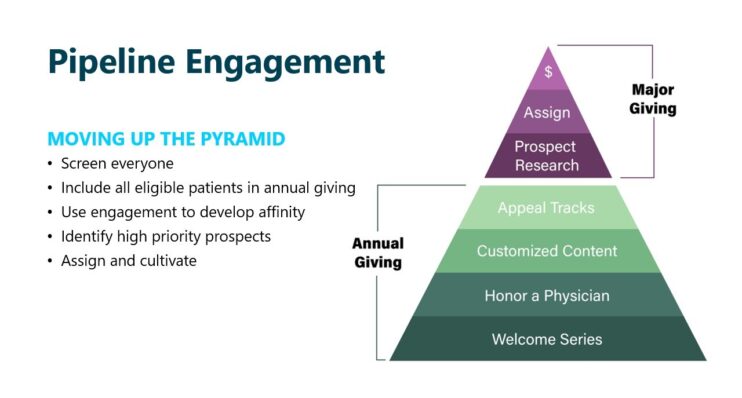Harnessing the Power of Grateful Patient Data

In healthcare fundraising, one of the most powerful tools often goes underutilized: grateful patient data. Hospitals and care institutions interact with thousands of patients every year, many of whom walk away feeling deeply thankful for the care they received. Some of these individuals are willing and able to give back—but only if they’re identified and engaged thoughtfully.
Fundraising teams can do exactly that by harnessing the power of grateful patient data. By carefully collecting and analyzing data from patients who’ve had positive experiences, hospitals and foundations can pinpoint those patients most likely to become donors. But using this data responsibly is key.
Can All Patient Data Be Used?
Not all patient data is suitable to include in fundraising efforts. Permissible data includes general patient demographics and contact information, as well as visit details—the date, treating physician, department visited, where they were seen and whether the appointment was inpatient or outpatient. With this foundation, teams can start identifying potential donors. It is essential to document approvals, your processes, where things are stored, and who has access.
To protect privacy and ensure ethical practices, certain information should be excluded:
- Negative outcomes: Patients involved in adverse outcomes, deaths, or legal cases
- Opt-outs: Individuals who have opted out of fundraising at the electronic health record (EHR) level
- Sensitive medical areas: Behavioral health, mental health notes, genetic testing, and cases involving communicable diseases or substance abuse
Building a Strategic Prospect Pipeline
Turning patient data into donor relationships requires more than just names on a list. A strong patient prospect pipeline is built on a combination of indicators, including:
- Wealth capacity: income, assets, stocks, etc.
- Inclination or propensity: modeling, frequency of gifts, and likelihood to give
- Affinity: emotional connection and engagement with the institution, such as:
- Engagement behavior: opening emails, clicking on specific content, or responding to surveys
- Volunteer activity: serving on event committees, boards, or advisory councils
- Visit history: recency and frequency of medical visits, including both past and future appointments, first visit date, total visits
Tip: Use a tiered prospect pipeline that classifies individuals by their level of engagement and likelihood to give. This ensures efficient allocation of time and resources toward the highest-potential prospects.

The Conversion from Patient to Donor
Transitioning patients into active donors requires thoughtful strategy and sustained engagement. Begin by placing every prospect into the annual giving pool so they begin to receive engagement opportunities. Your first outreach should be an email welcome series, sent to everyone:
- Share information and updates about your institution
- Offer ways for grateful patients to thank their care providers
- Ask for feedback
Grateful patients who have donated to the annual fund have a much higher likelihood of moving up the pyramid. When you receive a patient’s first annual fund gift, it often becomes important to do deeper prospect research, with the goal of assigning and cultivating the grateful patient for an appropriate major or transformational gift.
See how The University of Kansas Health System leverages grateful patient data
A one-time digital campaign delivered over just a month or two may not offer enough touchpoints to cultivate lasting donor relationships with grateful patients. Consider extending your strategy beyond that typical time frame. When you nurture potential supporters over a longer period and through a variety of channels, you can gain a deeper understanding of them, allowing you to meet patients where they are and encourage conversion at the right moment. Here are some suggestions:
- Implement a longer-term engagement track: Keep interested patients on a dedicated track to maintain communication and build trust over time.
- Refine your audience: Regularly evaluate engagement levels and remove individuals who are not interacting with your content or communications. This helps focus efforts and resources on those most likely to convert.
- Provide meaningful opportunities to connect: Send timely, relevant communications throughout the year. This ongoing engagement—through newsletters, surveys, updates, and stories—ensures your institution remains top-of-mind for your top prospects.
- Capitalize on key giving moments: Take advantage of notable fundraising events, such as GivingTuesday and National Doctors’ Day, by sending personalized solicitations.
The path from patient to donor is rarely linear. By extending engagement efforts and providing thoughtful, recurring touchpoints, you can significantly increase the likelihood of converting grateful patients into committed supporters. This sustained approach enhances your donor acquisition results and builds a foundation for lifelong relationships.
Data Management: Doing It Right
Handling patient data demands rigorous oversight. Because it involves Protected Health Information (PHI), security and compliance aren’t optional—they’re critical.
Best practices for data management include:
- Minimization: Collect and retain only the necessary data.
- Storage: Use encrypted systems that meet privacy regulations such as GDPR and HIPAA.
- Access Control: Limit access to only those who need it and use tools like Multi-Factor Authentication (MFA) and Single Sign-On (SSO).
- Transfer Procedures: Ensure all file transfers are secure, documented, and routinely reviewed.
Additionally, patient records should be marked inactive or removed if they haven’t resulted in a gift after a set period—typically five years. Don’t keep records if you don’t need them.
Final Thoughts
Grateful patient fundraising isn’t just about data—it’s about relationships. When used ethically and effectively, patient data can help healthcare institutions turn moments of gratitude into lasting support. With clear guidelines and strong data governance, hospitals can build donor pipelines that are both respectful and powerful.
To learn more, watch Blackbaud’s on-demand webinar: The Power of Grateful Patient Data.
 Free Resource
Free Resource


